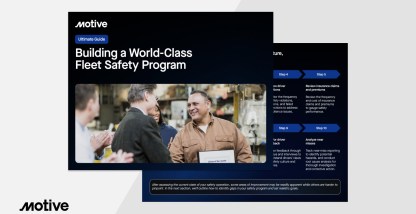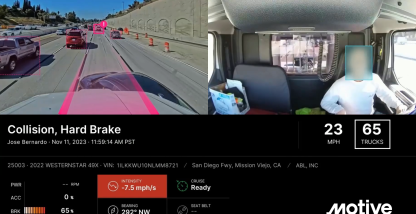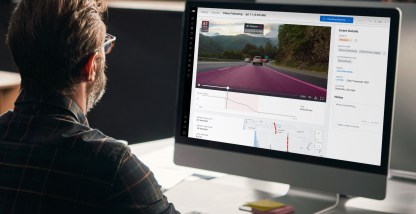The United States sees an average of 30 inches of precipitation annually, including hail, drizzle, sleet, and snow. But, it’s the rain that is most dangerous for commercial drivers.
Driver and fleet safety matter. This article shares tips for driving in the rain as a commercial driver and explores how technology can help too.
Why is driving in the rain dangerous?
Rain is the most dangerous of weather-related driving conditions. According to the Federal Highway Administration, “The vast majority of most weather-related crashes happen on wet pavement and during rainfall: 70% on wet pavement and 46% during rainfall.”
Even driving in light rain changes the conditions as the roads grow slicker. Storms and heavy rain can also limit visibility. Drivers risk skidding or hydroplaning. Plus, there’s the risk of other vehicle drivers making poor decisions such as driving too fast or aggressively even though the roads are wet. An accident for one driver becomes a dangerous lane obstruction for many others.
All these concerns are compounded for commercial drivers, so read on for driving in the rain safety tips. And, get access to additional fleet safety resources.
Read: 3 ways to coach fleet drivers to safer behavior.
Tips for driving in the rain
Although people tend to drive more carefully in sleet or snow, they don’t always react with the same caution when it rains. This makes the roads more dangerous for commercial drivers in the rain. Truck and bus drivers not only have to take greater care, but they also have to be wary of other vehicles on the road.
Tips for driving in the rain as a truck driver
First, try not to be surprised by rain. Check the weather forecast before setting out on a trip. Plus, you’ll know to check tire inflation and to make sure that windshield wipers and window defrosters are working properly.
Of course, you won’t always be prepared. When out on the roads in the rain, it’s important for drivers to test their brakes and know to drive slower. It’s going to take longer to come to a complete stop on wet roads. The risk of skidding or hydroplaning can be higher if the truck’s center of balance has changed with cargo shifting unexpectedly on the journey.
Remember also to give other vehicles more room and advance notice of your intentions. Avoiding sudden stops and being careful when driving through puddles are also smart tips for driving in the rain.
Even after the rain stops, keep an eye out for moving water on the side of the road. This can make the vehicle’s tires lose traction, which can cause you to lose control.
Drivers should also be aware of the adverse driving conditions exception, which allows drivers who carry property and who encounter unexpected driving conditions to extend their maximum 14-hour on-duty and 11-hour driving time periods.
Tips for driving in the rain as a bus driver
Driving a bus in the rain is even more fraught as you could have children on board. That’s another kind of precious cargo! Just as suggested for the truck driver driving in the rain, it’s advisable to check weather conditions before setting out. Bus drivers can also proactively confirm that their bus is in optimal shape to handle the expected rain.
On the roads, we’ll reiterate the importance of driving slower and testing brakes. Avoiding aggressive driving behaviors and signaling any lane changes well in advance can also help other drivers. After all, they’re going to need longer to react and are suffering visibility challenges too.
Be especially wary in the first 10 minutes after the rain begins. This is a particularly dangerous time as the rain will mix with the oil on the road to make roads slicker. After the rain washes the oil away, the roads will be safer but you should still drive cautiously.
How to respond to a skid in the rain
First, let’s clarify the difference between skidding and hydroplaning. Skidding happens on slick roads while hydroplaning occurs when standing water on the road is deep enough that the treads lose contact with the road. The National Safety Commission tells us “this can occur at speeds as low as 35 mph and becomes most dangerous at 55 mph or more.”
Nevertheless, you’ll respond to both skidding and hydroplaning in the same way. If you begin to lose control of the car, remove your foot from the gas. Don’t slam on the brakes. The best braking behavior depends on your type of brakes. Those with standard brakes won’t want to apply the brakes. If the skid started while applying the brakes, remove your foot from the pedal. Only in an anti-lock braking system (ABS) vehicle does it help to apply firm pressure when you start to skid or hydroplane.
Drivers in a bus with an automatic transmission will want to downshift one gear. A standard transmission bus will slow down more on its own, but shifting to neutral or depressing the clutch will help.
Turn in the direction of the skid — the direction the front of your car wants to go — until you regain full control and the car has slowed on its own.
Tips for driving in the rain at night
Driving in the rain at night? Turn on your vehicle’s lights. Turning on your high beam lights isn’t a good idea, though, as they will be too reflective and can make it more difficult for both you and other drivers to see.
In fact, drivers are required to turn on vehicle headlights when it rains in many states (day or night). This is meant to improve your visibility and the ability of other drivers to see you. A newer car comes with automated running lights but, in the rain, turning the actual headlights on will also turn on the backlights.
State Farm notes it’s also good practice to dim the dashboard lights, which can reduce glare. Additionally, avoid looking at oncoming headlights and ventilate your car to help reduce fog forming inside your windows.
Why shouldn’t you use hazard lights in the rain?
When driving in heavy rain, you may also see drivers turn on their hazard lights. However, several states have made this illegal. “Hazard lights are for vehicles that are stopped and pulled over on the side of the road. It is not for moving vehicles,” Public Safety Information Coordinator Eddy Durkin told AccuWeather. “So — regardless of the weather conditions — if you are driving a moving vehicle, do not activate your flashing lights; it will only cause confusion and compromise your safety.”
Why should you avoid cruise control in the rain?
It’s never a good idea to use cruise control in the rain. Yes, cruise control can help with speed and fuel management. Yet, if using cruise control in the rain, the vehicle will respond exactly the wrong way to a skid situation. When cruise control detects that your tires are starting to spin, it corrects this by increasing vehicle speed. Instead, you want to take your foot off the gas.
How to keep safe in all weather conditions with Motive
These rainy weather safety tips will help commercial drivers. Yet, the person in the driver seat doesn’t need to be solely responsible for safe driving in challenging weather conditions. Motive’s fleet safety solution maps weather conditions in fleet view and helps fleet managers plan the entire route in advance with safety in mind, simplifying the process of vehicle fleet management.
Our DRIVE program contextualizes critical safety events, considering weather as well as road conditions and driver action and more. This lets your safety department see specific driver scores and behaviors to immediately take action.
Another risk when driving in the rain? Distracted driving. With GPS tracking and live camera streaming, drivers are held accountable to the commercial company’s safety standards. Fleet management software also makes it easier to identify best- and worst-performing drivers and simplifies driver coaching too.
Request your free demo today.









